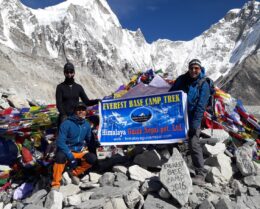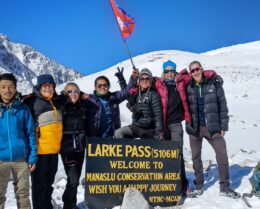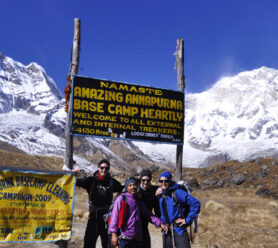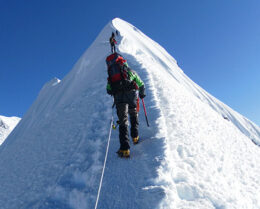Everest Base Camp Trek in April- Sunny and Warm Weather
PUBLISHED ON 4 April, 2024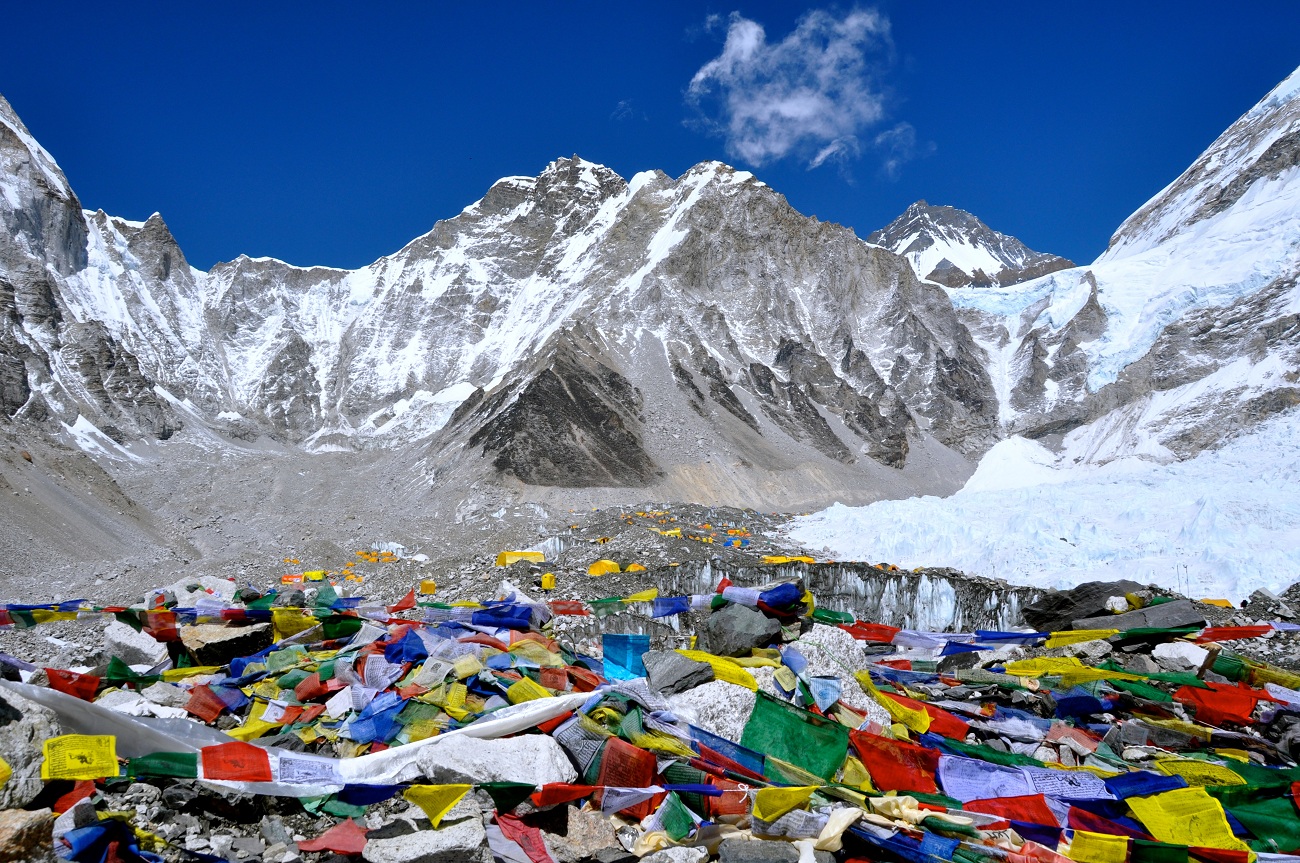
Nepal is home to Everest Base Camp, also known as South Base Camp. It is located 5,364 meters above sea level. Multiple isolated hill trails are up and down throughout the walk, making it quite difficult. However, the EBC is a valuable adventure that offers you the opportunity to witness the splendor of the Himalayas. Everest Base Camp Trek in April provides a link to the Sherpa culture. You can see the tallest mountain in the world in all of its beauty.
It’s an experience of a lifetime for anyone searching for a unique and unforgettable mountain encounter. With its varied and stunning surroundings, it is like the stairs to heaven.
The significance of April as the ideal month for hiking
Trekking to the Everest Base Camp in April is one of the most popular trekking months in the Himalayas. This covers the well-known hikes to Kalapathar and Everest Base Camp. This decision is supported by several important considerations.
April is often a month with consistent good weather. The days are pleasant and the sky is mostly clear this time. This makes it ideal for hiking and taking in the breathtaking vistas. You can take pictures of the stunning mountain vistas.
The Best Time for the Everest Base Camp Trek: in April
The season adds a touch to the area’s natural attractiveness. Hikers can see rhododendron blossoms flowering at lower elevations. Because of the beautiful weather and excellent visibility, trekking is enjoyable and unforgettable.
Moreover, a lot of traffic still uses the trail because of April’s popularity. It’s far less crowded than in October and November when trekking is at its peak. On the other hand, trekking in April is a more calming and fulfilling experience.
April is a popular month for trekking in the Everest region because of all these factors. Travelers from all over the world are drawn to begin this amazing walk in the Himalayan foothills because of this.
Trekkers should expect challenges and excitement.
In April, visiting Everest Base Camp offers a unique combination of thrilling adventures and formidable challenges. The possibility of getting up close to Mount Everest, the highest mountain in the world, is the first thing that excites me about this journey. The stroll will take you through an incredible variety of landscapes.
Hiking over difficult, high-altitude terrain, you will pass Sherpa settlements and lush rhododendron trees. Every day, new and intriguing discoveries are made. It offers everything from colorful prayer flags to ancient monasteries that give the impression that time has stood still.
Traffic on Everest Base Camp Trek in April
But all of this excitement comes with real challenges. Because of the high altitudes, there’s always a possibility of developing acute mountain sickness (AMS). Because of this, trekkers need to be careful with their physical well-being and acclimatization.
The weather in the Himalayan area is unpredictable. It demands flexibility in the face of unforeseen circumstances like precipitation. The hike may be physically taxing because to its long, steep climbs and descents. Simple teahouses could have small rooms. However, forcing the shift to a more rural way of life is imperative.
Nevertheless, these difficulties make the expedition to Everest Base Camp worthwhile. Overcoming hurdles to altitude and physical challenges helps one feel accomplished. This will help you form a stronger bond with the untamed environment.
The Himalayas are breathtakingly beautiful, and the Sherpa culture is incredibly kind. Because of this, the journey is an amazing experience. A trip gains appeal when it blends excitement and difficulty. Not only does this captivate onlookers, but it also transforms the lives of those who dare to do it.
Weather and Climate in April – Reliable and Pleasant Climate
For hikers who want to visit the Everest region, The Everest Base Camp Trek in April is a popular alternative. This trek is regarded as one of the most significant periods to travel. The weather and climate conditions are perfect for April month time of year. Weather permitting, an April trek to Everest Base Camp should conclude in fine conditions.
The spring season trekking in the Everest region starts in April. The weather is usually reliable, pleasant, and has moderate daytime temperatures. You can anticipate pleasant trekking conditions with a clear sky at this time of year.
April offers beautiful springtime weather at Everest Base Camp. April daily highs in EBC are typically between 15°C and 20°C (59–68°F). It’s usually warm enough and best for trekking.
The temperature at night can drop significantly at higher heights. At night, the temperature ranges from -5°C to 5°C (23°F to 41°F). Being prepared for chilly weather is crucial. You should become more cautious as you approach the upper height of the trail.
Pre-monsoon season and its impact on trekking
When it comes to the summer monsoon season, April receives less rain than June. However, considering it’s the pre-monsoon season, rain is likely in certain places. This could make the path muddy and difficult to follow. If you’re lucky, there won’t be any rain, even though it’s not yet monsoon season.
Benefits and considerations of Everest base camp trek in April
Mild Temperatures: April frequently has warmer weather than winter. It might, however, still be chilly at higher heights. Daytime temperatures can range from 15 to 20°C (59 to 68°F) at lower elevations. Thus, nightly lows below freezing can occur at higher elevations.
Vistas of colorful mountains: April is usually a sunny month. This provides beautiful views of the mountains throughout the way. Your view of the Himalayan peaks will be breathtaking. There are numerous mountains in the distance, including Mount Everest, Lhotse, Nuptse, and Ama Dablam.
Rhododendron Blooming: In April, the rhododendron starts to bloom. Bloomy trees can be seen at the lower elevations along the path. The breathtaking, multicolored blossoms on the trip add to its overall grandeur.
Less Crowd
April is a popular month for trekking in the Everest region. Compared to October and November, when trekking is most popular, it is less congested. You will most likely encounter fewer hikers on the path. This resulted in better accommodations for you.
April is ideal for photography since there are so many amazing photo opportunities. It will have brilliant skies and blooming flowers, akin to the peace of heaven. The splendor of this season and its sunny days are ideal for highlighting the surroundings’ allure.
Beautiful Tea Houses: In April, the teahouses along the trail are prepared to receive hikers. There is no possibility that a strong cold or snowfall will force teahouse closures.
Festivals of Spring:
You might be able to witness the celebration of the regional spring festivals. This event is being held throughout the Sherpa villages. However, this is dependent on when you embark on the hike.
April boasts longer daylight hours than other months. Consequently, you will have more time to go trekking. There are also more opportunities to explore the region and its environs.
Training and physical preparedness: For the Everest Base Camp Trek in April
Essential physical training and fitness are also needed for the April Everest Base Camp Trek. At elevations above 5,000 meters (16,400 feet), the journey takes place. This has several steep ascents and descents.
Those who are not physically equipped for these high-altitude situations may become fatigued. Apart from physical fatigue, there’s a possibility of altitude-related issues including acute mountain sickness. A fitness program that works is simple and efficient.
Significance of physical preparedness: For The Everest Base Camp Trek in April
To make the trek to Everest Base Camp (EBC) truly captivating, one must be physically fit. Walking over some of the most difficult terrain is a tiring experience. It features rugged terrain, rocky trails, and steep hills. Therefore, your level of protection greatly depends on your physical fitness. It also increases your stamina for extended hikes in altitude. This makes the overall trekking experience easier and more convenient.
Additionally, if you’re in superior physical condition, you might heal more quickly. Pain and injuries are therefore less common. Plus, it makes lugging your gear easier, which could result in cost savings.
Tools and Equipment
Buying or renting equipment is necessary for your Everest Base Camp trek in April. It’s essentially a component of expedition planning. Take into consideration these wise recommendations:
Renting vs. Buying: Determine which option is more cost-effective by weighing the prices of renting against purchasing specific things.
We can easily find the necessary equipment in Namche Bazaar and Kathmandu. This covers sleeping bags, down jackets, and trekking poles. Purchasing, however, might be a better long-term option for items like boots or clothing.
Recognize your needs: Make lists of all the equipment you will require first. Make sure that your top priority is a high-quality down jacket, hiking boots, and sleeping bags. Realize that certain equipment can be hired in Nepal. Pack some items from home, such as comfortable shoes.
Businesses of rental gear:
There are a lot of gear businesses in Kathmandu’s Thamel neighborhood. When renting, look for reputable rental companies. Make sure that the equipment is in good operating order at all times. Ensure that it is always maintained and kept clean. Kindly locate details regarding their return policies.
Quality and Authenticity:
Exercise caution when buying counterfeit items. Some inexpensive products might not provide the required warmth and protection. You need to pack additional warm clothing for the Himalayan region’s harsh weather. Invest in high-quality gear that is suitable for trekking at high altitudes.
Size Matters: Make sure the gear you purchase or rent fits you properly. When traveling, blisters and other discomforts could result from wearing unsuitable shoes or clothing. Take some time to check and test your equipment before you embark on your hike.
Plan:
You may want to think about booking equipment in advance if you plan to rent in Kathmandu. This is especially useful if you’re trekking in April, which is the busiest month.
Workouts and Diet
It takes a thorough fitness regimen to go to Everest Base Camp (EBC) in April. Vitality in the heart is essential. At least four or five days a week should be dedicated to physical activity, such as cycling, jogging, or trekking. Workouts that are longer and more intensive should be gradually increased.
This simulates the long days of trekking more accurately. Strength training that focuses on your upper and lower body will help you negotiate the various terrains more effectively. Engage in stretching and flexibility-promoting exercises, like yoga. Preventing strained muscles is crucial. Furthermore, the success of the April EBC adventure depends on mental toughness.
Essential supplies and equipment for the Everest base camp trek
Make sure you are ready for the excursion by bringing the appropriate hiking gear. At high altitudes, always dress appropriately for the weather. Get in touch with the hiking company for a recommended packing list. As an alternative, you might pack for the climate and seasons of Nepal.
Specific considerations for Everest Base Camp trekking in April
- Trekking to Everest Base Camp is most prevalent in April. Rhododendron flowers in various colors, moderate days, and pleasant weather are all present throughout this period. Even though this is a popular month for trekking, there are a few factors to consider.
- Higher heights have pleasant days but chilly nights. Plan accordingly for temperature drops.
- The trail will see a lot of traffic in April, making it a busy month. To prevent crowds, reserve your lodging in advance. At well-known teahouses, limited spaces may fill up quickly.
- It’s recommended that you take high-altitude safety measures. This includes being adequately hydrated, acclimatized, and informed of the symptoms of acute mountain sickness.
- Continue eating a balanced diet and getting enough water. By doing this, gastrointestinal issues can be prevented.
- Keep up drinking enough water and eating a balanced diet. Gastrointestinal problems can be avoided by doing this.
- To adapt to changing temperatures, wear layers. Sun protection is required because of the strong April sun at high heights.
- Travel insurance is a must for high-altitude trekking and emergency evacuation. It’s also critical to be prepared for weather changes and challenges associated with altitude.
Acclimatization and altitude sickness
In the Himalayas, the weather is not always dependable. It’s important to stay vigilant because the weather can change suddenly. The considerable elevation gain on the trek increases the risk of acute mountain sickness (AMS). It’s important to adjust appropriately. Recognizing how altitude affects the EBC journey
The April journey to Everest Base Camp is greatly impacted by altitude. You get less oxygen as you ascend. This could lead to lower air pressure and reduced absorption of oxygen. It is possible to develop altitude-related diseases such as acute mountain sickness (AMS). The body must properly acclimate for it to gradually adapt to these shifting circumstances. Steer clear of dangerous ailments when hiking.
The significance of gradual climb and acclimatization
A gradual ascent and acclimatization period are crucial for high-altitude hikes such as the EBC. They enable the body to adapt to reduced oxygen concentrations. This will reduce the likelihood of developing altitude-related disorders including acute mountain sickness (AMS). A safe and enjoyable trek is guaranteed with proper acclimatization and a leisurely pace. However, hurrying the trip could lead to major health issues.
Permits
The trekking company helps you acquire the required permits, such as the TIMS (Trekkers’ Information Management System) card and the Sagarmatha National Park Permit.
Accommodation
A vital component of the experience is the lodging offered during the April Everest base camp hike. At the teahouses, also known as trekking lodges, hikers can unwind and refuel after a demanding walking day.
When the hikers arrive in April, these teahouses will be ready. They offer basic but comfortable lodging. A basic room with two beds is the typical type of lodging. On the other hand, certain resorts have shared facilities, while others have private restrooms.
The modest apartments offer cozy protection from the winter cold in the mountains. In these teahouses, substantial meals including a variety of regional and global cuisines are provided in the dining areas. Furthermore, hikers congregate in public spaces all night long to share stories.
They enjoy having other explorers as partners. Trekking is very popular in April, therefore bookings should be done well in advance. This facilitates access to food, shelter, and these teahouses. It fosters a sense of camaraderie throughout this incredible April Everest base camp journey.
Consumption of food and drink
Maintaining a nutritious diet and regular hydration schedule is essential. This is essential for an amazing and fruitful April Everest base camp hike. Trekking at high altitudes requires a lot of energy. For this reason, maintaining a balanced diet is crucial.
Local dishes like momos and Dal Bhat contain elements of Nepali cuisine. These lunches in tea houses have the potential to be both delicious and healthy. It’s important to eat and drink enough water, especially in the chilly mountain environment. Teahouses along the road serve hot beverages, such as herbal teas and ginger and lemon drinks. These beverages can provide both hydration and warmth.
Fresh food may be scarcer at higher elevations. As a result, adding energy bars, nuts, and dried fruits is recommended. It is perfect for on-the-go snacking and ensures a steady intake of nutrients. These dietary and hydration strategies support your continued energy levels. It also enhances the convenience and enjoyment of your entire hiking experience.
Safety and Health
Good trekking weather is guaranteed in April in the Everest region of Nepal. Therefore, hikers should keep an eye out for common ailments. An acute case of mountain sickness (AMS) could occur. As you go to the upper elevation of the trek, the AMS probably gets worse.
A gentle stroll and thorough acclimatization can help prevent the AMS. Cold-related illnesses can be avoided if one is dressed appropriately and has the right gear. Dehydration is a serious problem in the mountains due to the dry air. As a result, it’s critical to continue drinking water.
Furthermore, gastrointestinal problems are very communicable. You can avoid it by practicing mindful eating and good hygiene. It’s crucial to protect oneself from UV rays and sunburn when at high altitudes. Similarly, consuming plenty of water and dressing warmly lowers the chance of contracting respiratory diseases.
Trekkers should also take careful care of their feet to prevent blisters. It is imperative to be prepared for these common health issues. Take the necessary steps to guarantee a safe and enjoyable trip in April.
Conclusion
All in all, the trip to Everest base camp in April is the greatest. However, it’s critical to be prepared for erratic weather conditions. When you travel to higher heights, always be prepared for lower temperatures.
Make sure you have everything you need to be warm and are dressed appropriately. You also gained knowledge about how to spot the symptoms of altitude sickness. Since this is the busiest trekking season, book accommodations and permits well in advance.

